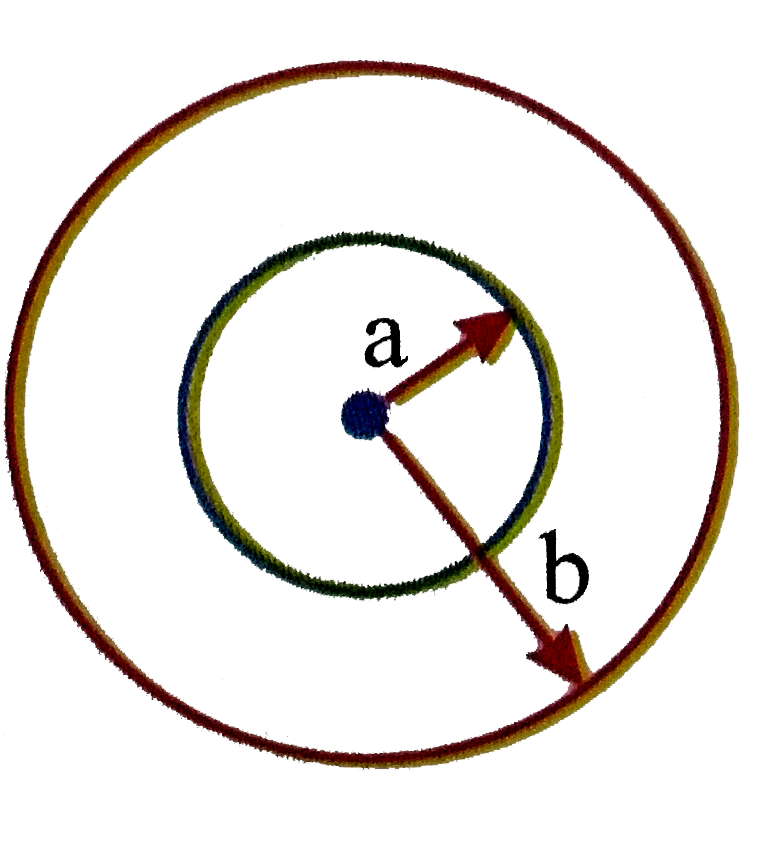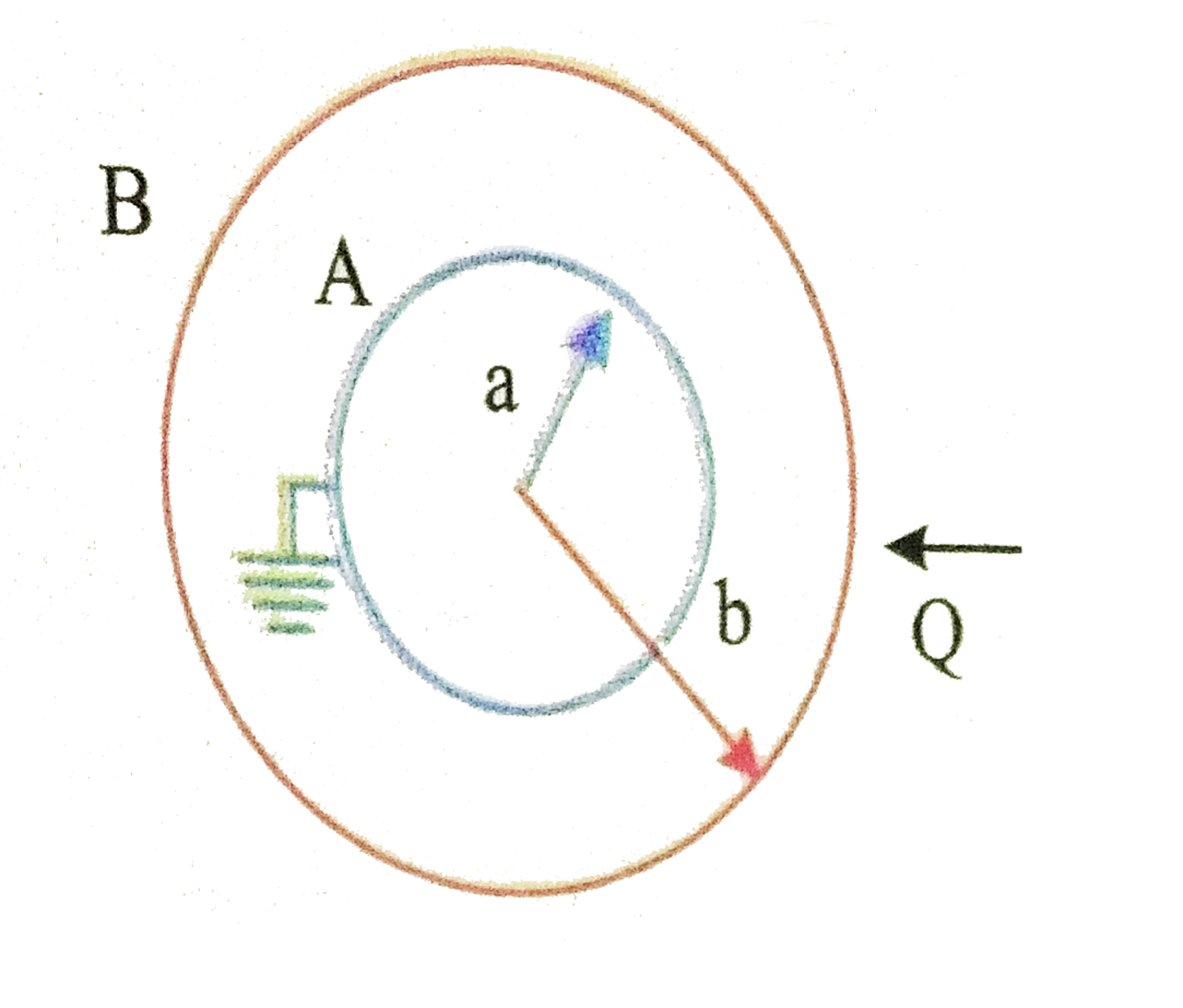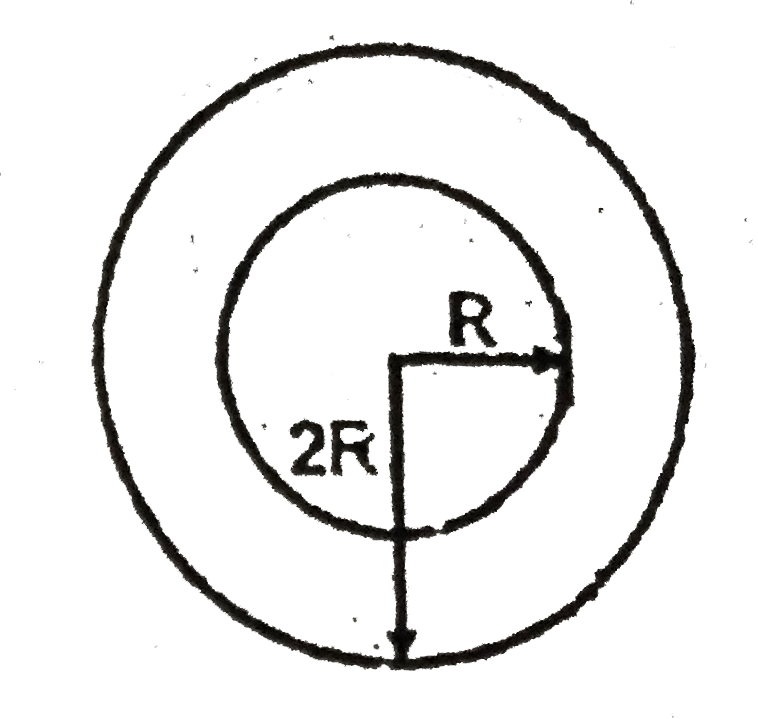There are two concentric conducting shells. The potential of outer shell is 10 V and that of inner shell is 15 V. If the outer shell is grounded, the potential of iner shell becomes / remains.
25 V
15 V
10 V
5 V
The correct Answer is:D
To solve the problem of two concentric conducting shells, we need to follow these steps:
Step 1: Understand the Initial Conditions
We have two concentric conducting shells:
- The potential of the outer shell (V_outer) is 10 V.
- The potential of the inner shell (V_inner) is 15 V.
Step 2: Grounding the Outer Shell
When the outer shell is grounded, its potential becomes 0 V. This means that the charge distribution on the outer shell will adjust to ensure that its potential is zero.
Step 3: Use the Formula for Potential
The potential (V) at a point due to a spherical shell of charge is given by:
V=kQr
where:
- k is Coulomb's constant,
- Q is the charge of the shell,
- r is the distance from the center to the point where the potential is being measured.
Step 4: Set Up the Equations
1. For the outer shell (before grounding):
Vouter=kQouterR+kQinnerr=10V
2. For the inner shell:
Vinner=kQouterR+kQinnerr=15V
Step 5: Subtract the Equations
By subtracting the equation for the outer shell from the equation for the inner shell, we can isolate the terms involving the charges:
(kQinnerr−kQouterR)=15−10
This simplifies to:
kQinnerr−kQouterR=5(1)
Step 6: Grounding Effect on Outer Shell
When the outer shell is grounded, its potential becomes 0 V:
0=kQouterR+kQinnerr
This can be rearranged to:
kQouterR=−kQinnerr(2)
Step 7: Substitute Equation (2) into Equation (1)
Substituting equation (2) into equation (1):
−kQinnerr−kQinnerR=5
Factoring out kQinner:
kQinner(−1r−1R)=5
Step 8: Calculate the New Potential of Inner Shell
Now, we need to find the new potential of the inner shell after grounding:
Vinner,new=kQouterR+kQinnerr
Using the grounded condition:
Vinner,new=−kQinnerr+kQinnerr
This results in:
Vinner,new=5V
Conclusion
Thus, when the outer shell is grounded, the potential of the inner shell becomes 5 V.
We have two concentric conducting shells:
- The potential of the outer shell (V_outer) is 10 V.
- The potential of the inner shell (V_inner) is 15 V.
When the outer shell is grounded, its potential becomes 0 V. This means that the charge distribution on the outer shell will adjust to ensure that its potential is zero.
The potential (V) at a point due to a spherical shell of charge is given by:
V=kQr
where:
- k is Coulomb's constant,
- Q is the charge of the shell,
- r is the distance from the center to the point where the potential is being measured.
1. For the outer shell (before grounding):
Vouter=kQouterR+kQinnerr=10V
2. For the inner shell:
Vinner=kQouterR+kQinnerr=15V
By subtracting the equation for the outer shell from the equation for the inner shell, we can isolate the terms involving the charges:
(kQinnerr−kQouterR)=15−10
This simplifies to:
kQinnerr−kQouterR=5(1)
When the outer shell is grounded, its potential becomes 0 V:
0=kQouterR+kQinnerr
This can be rearranged to:
kQouterR=−kQinnerr(2)
Substituting equation (2) into equation (1):
−kQinnerr−kQinnerR=5
Factoring out kQinner:
kQinner(−1r−1R)=5
Now, we need to find the new potential of the inner shell after grounding:
Vinner,new=kQouterR+kQinnerr
Using the grounded condition:
Vinner,new=−kQinnerr+kQinnerr
This results in:
Vinner,new=5V
Thus, when the outer shell is grounded, the potential of the inner shell becomes 5 V.
Topper's Solved these Questions
- ELECTROSTATIC POTENTIAL AND CAPACITANCE BOOK - AAKASH INSTITUTE ENGLISHCHAPTER - ELECTROSTATIC POTENTIAL AND CAPACITANCE EXERCISE - SECTION-C (OBJECTIVE TYPE QUESTIONS (More than one answer))
13 Videos
- ELECTROSTATIC POTENTIAL AND CAPACITANCE BOOK - AAKASH INSTITUTE ENGLISHCHAPTER - ELECTROSTATIC POTENTIAL AND CAPACITANCE EXERCISE - SECTION-D(COMPREHENSION-I)
2 Videos
- ELECTROSTATIC POTENTIAL AND CAPACITANCE BOOK - AAKASH INSTITUTE ENGLISHCHAPTER - ELECTROSTATIC POTENTIAL AND CAPACITANCE EXERCISE - SECTION-B (OBJECTIVE TYPE QUESTIONS (ONLY ONE ANSWER) )
1 Videos
- ELECTROMAGNETIC WAVESBOOK - AAKASH INSTITUTE ENGLISHCHAPTER - ELECTROMAGNETIC WAVESEXERCISE - ASSIGNMENT SECTION - D Assertion-Reason Type Questions
25 Videos
- GRAVITATION BOOK - AAKASH INSTITUTE ENGLISHCHAPTER - GRAVITATION EXERCISE - ASSIGNMENT SECTION - D (ASSERTION-REASON TYPE QUESTIONS)
15 Videos
Similar Questions
If the electric potential of the inner shell is 10V and that of the outer shel is 5V, then the potential at the centre will be

View SolutionThere are two concentric conducting spherical shells of radii 10cm and 20cm. The outer shell is charged to a potential of 50esu while inner shell is earthed. The charge on outer shell is
View SolutionIf the electric potential of the inner metal sphere is 10 volt & that of the outer shell is 5 volt then the potential at the centre will be

View SolutionConsider two concentric spherical metal shells of radii 'a' and b>a .The outer shell has charge Q but the inner shell has no charge.Now the inner shell is grounded ,This means that the inner shell will come at zero potential and that electric fields lines leave the outer shell and end on the inner shell.(a) Find the charge on the inner shell
Find the potential on outer sphere.

View SolutionThree concentric conducting sphereical shells carry charges +4Q on the inner shell −2Q on the middle shel and +6Q on the outer shell. The charge on the inner surface of the outer shell is
View SolutionA conducting shell S1 having a charge Q is surrounded by an uncharged concentric conducting spherical shell S2. Let the potential difference between S1 and that S2 be V. If the shell S2 is now given a charge −3Q, the new potential difference between the same two shells is
View SolutionIn the figure two concentric conducting shells of radius R & 2R are shown. The inner shell is charged with Q and the shell is unchanged. The amount of energy dissipated when the shells are connected by a conducting wire is:

View SolutionThree concentric conducting spherical shells carry charges as : +4Q on the inner shell, −2Q on the middle shell and −5Q on the outer shell. The charge on the inner surface of the outer shell is
View Solutionthere are two concentric metallic shells of radii R and 2R, if outer shell is given charge q1 , then charge on surface of inner shell will be
View SolutionThere are two concentric conducting spherical shells of radius rA and rB respectively (rB=2rA). If the inner shell is given a charge Q and outer shell is given a charge 2Q, then the potential difference between the surfaces of the shells will be K=14πε0
View Solution
